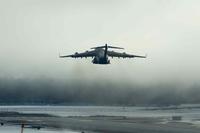A U.S. House of Representatives committee on Tuesday voted to scrap the Air Force's A-10 Warthog gunship, becoming the first congressional panel to do so.
The House Appropriations Committee, headed by Rep. Hal Rogers, R-Kentucky, voted 23-13 against an amendment to the annual defense spending bill that would have preserved funding for the Cold War-era aircraft in fiscal 2015, which begins Oct. 1.
"Respectfully, let me stipulate at the onset that the A-10 Thunderbolt is a tremendous aircraft," Rep. Rodney Frelinghuysen, R-New Jersey, who chairs the panel's defense subcommittee, said before the vote. "It is, though, 30 to 40 years old ... [and] close-air support is not the only mission the Air Force must be able to perform."
The Air Force proposed retiring the 283 A-10s remaining in the fleet by 2019 to save an estimated $4.2 billion over five years. The proposal was developed in response to congressionally mandated automatic budget cuts known as sequestration.
Lawmakers on both the House and Senate Armed Services Committees disagreed with the service's plan and voted to restore funding to keep the planes flying for at least another year. But the House appropriators' vote against transferring $339 million from the Pentagon's operations and maintenance account to sustain the A-10 means the aircraft could still be sent to the bone yard.
The amendment to save the gunship, known unofficially as the Warthog, was introduced by Rep. Jack Kingston, R-Georgia, and several of his colleagues spoke in support of the proposal, including Sanford Bishop, Jr., D-Georgia; Ed Pastor, D-Arizona; and Chris Stewart, R-Utah, who served in the military as an Air Force pilot.
"We flew operational and training missions with the A-10 all the time," Stewart said. "Close-air support is a very, very delicate mission. It's best done at 350 knots and 50 feet -- not at 40,000 feet and 600 knots. When you have troops that are in close contact with the enemy on the ground, it's a very, very precise mission.
"It's also a very unforgiving mission," he added. "If you go out and you hit the wrong bridge, people are going to forgive you for that. But if you go out and frag your own troops -- in the first place, you'll never forgive yourself and in the second place, you're going to end up in the newspaper. It's just something that's very difficult to do at the speed and altitudes that some of these other aircraft do it at."
Five U.S. troops were killed on Monday in an apparent friendly fire strike in southern Afghanistan, according to the Defense Department. They had reportedly requested close-air support from a B-1 bomber.
In defending the decision to retire the A-10, Frelinghuysen said the F-16 fighter jet and the B-1 bomber can do what the A-10 does, but the reverse isn't true.
The measure will save "billions, not millions" of dollars, he said. "This money could be plowed back into the procurement of modern, multi-mission aircraft and research and development of a new generation of unmanned systems [and] a new long-range strike bomber."







